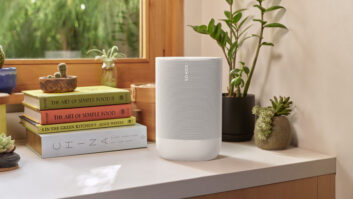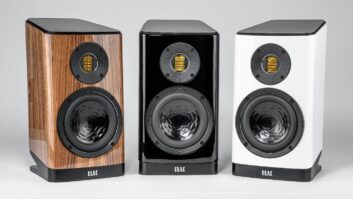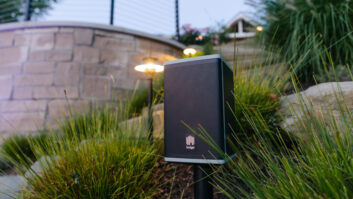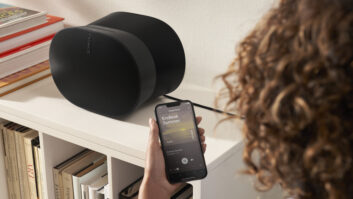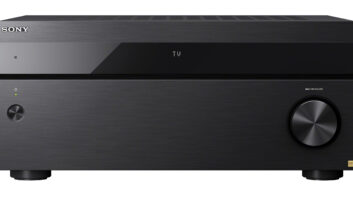When the Sonos Move was released in September 2019, it quickly became my go-to portable speaker. Solidly built, works on Wi-Fi or Bluetooth, convenient carry handle and charging base, and it sounds great — plus the Sonos software backbone — it checks all the boxes. And not just for me, I would regularly see Moves in the wild — tucked into corners at cafes or at the edge of the patio at a vineyard.
Three years later, it still performs as it did, but Sonos has upped the ante with its sequel, the Move 2. Let’s find out if your clients should make the upgrade.
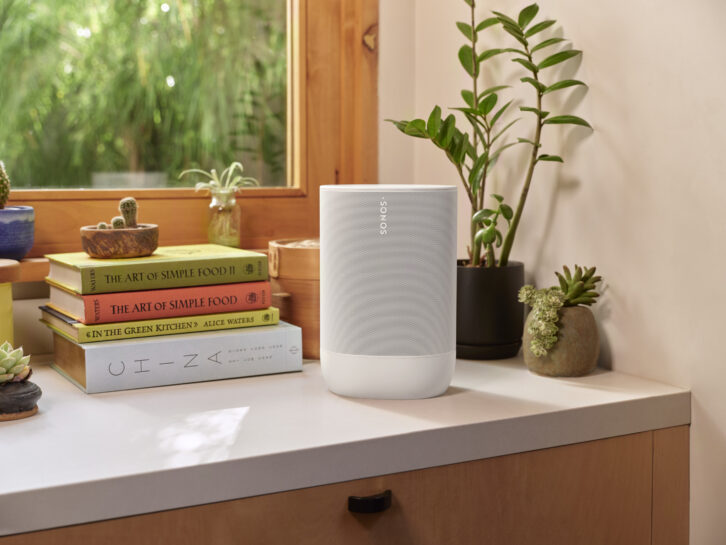
Unboxing and Setup
With many products aimed right at consumers, Sonos’ packaging is always appealing, and the Move 2 is no different. On top of its minimalist efficiency, the package uses sustainably sourced content and zero virgin plastic. However, the box containing the power adaptor seemed a tad deeper than it needed to be, causing me to remove the cardboard cradle inside just in case there was something below it. (There wasn’t.)
Setup could not be easier and follows the typical Sonos procedure for adding a portable to the Wi-Fi network. Turn it on, open the Sonos app, find the speaker, find the network, and join them together. The Move 2 needed a software update, which was downloaded and installed quickly while I read more about the speaker.
The back panel of the Move 2, nestled in the recess that makes the easy carry handle, holds two buttons — one for Power and the other to connect to Bluetooth — and a switch to turn the microphone on and off. Security-minded clients may prefer the mic off, but then they can’t take advantage of the automatic Trueplay feature, which listens and adjusts the speaker for optimal performance in the location it is in — and does a nice job of it.
Further down the back of the speaker, out of the recess, is a USB-C port that lets users charge their phones on the run or connect a turntable, computer, or other audio source using the Sonos Line-In Adapter.
Speaking of power, the power cradle was one of my favorite things about the original Move — no fastening or clicking-in needed, just lay the speaker in the open oval and it never fails to connect and charge — and the Move 2 has kept that the same, and even reduced the size of the plug. The Move 2 will work with the original power adapter, which is good news for clients who want to upgrade and who have run the power cord behind furniture or in other hard-to-move areas.
What’s the Same/What’s Different
Like the original, the Move 2 is water-resistant with an IP56 rating. From the front, it has a very similar look to the Move, except for the Sonos logo on the new version being less pronounced than on the previous, with it being a subtle dark grey on the black model I was sent.
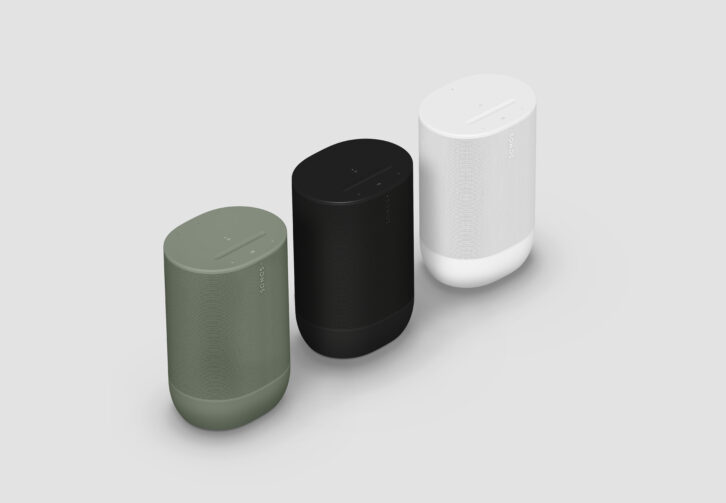
As for different, in addition to the smaller wall wart, the Move 2 features a new on-device volume control — an indented channel that is on the top of the unit, and that I liked very much. Not only is it easy to use, but there is an audible tone to let you know the volume has been raised or lowered a tick (or several ticks).
Also new is an enhanced battery that Sonos says offers 24 hours of playback on a single charge. I didn’t put that to the test, but the Move 2 held its charge well, even when left unplugged for days. The original Move had about 10 hours, and I had never run out, which is not only a testament to the battery but also to the ease of charging, as it regularly lives on its base.
The Move 2 adds a second tweeter for enhanced stereo separation. I couldn’t hear true stereo, but the soundfield definitely felt bigger. Not only is the soundfield expanded, but the overall sound is fuller, especially at the low end. It still uses a single mid-woofer, but the new version provides a clarity that is noticeably deeper and more precise than the original.
One of my go-to test tracks is Marianas Tech’s “Echoes of You” from their album Phantoms. Part of the reason is that I got to interview lead singer/producer Josh Ramsay for Mix magazine about the song, and he gave me plenty to listen to, plus the song has all sorts of different dynamics, harmonies, orchestrations, and even a Theremin. I’ve listened to it on portable speakers and a $300,000 2-channel system. So, I’m pretty familiar with it.
While you can’t pair a Move 2 to a Move in stereo (you can pair two Move 2’s in stereo), you can group the speakers, which I did and placed them in two different rooms and fired up “Echoes of You.” I then ran between the two rooms as part of the listening tests. Then I switched the speakers to take the rooms out of the equation — and because they are portable and easy to move.
Without a doubt, the Move 2 delivered a richer experience — particularly in the low-end, which greatly enhanced the song and gave a pretty good approximation of how it sounded on larger, more expensive speakers.
Worth an Upgrade?
The two main selling qualities of the Move 2 over the original Move are the increased sound performance and the longer-lasting battery, which, if important to a client, then it will be easily worth the $50 increase (the Move 2 is $449; the Move is $399).
It should be noted that Sonos has another portable speaker called the Roam, which is considerably smaller than either Move. The choice between a Roam and Move 2 should be fairly obvious for clients — if they plan on taking the speaker far outside the home in a backpack or another long-term carry situation, the Roam is it. But if you need to move a speaker around the home and yard, the Move 2 has you covered with a long-playing, great-sounding, easy-to-use wireless solution.
